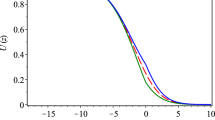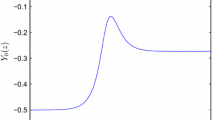Abstract
Variation in genotypes may be responsible for differences in dispersal rates, directional biases, and growth rates of individuals. These traits may favor certain genotypes and enhance their spatiotemporal spreading into areas occupied by the less advantageous genotypes. We study how these factors influence the speed of spreading in the case of two competing genotypes under the assumption that spatial variation of the total population is small compared to the spatial variation of the frequencies of the genotypes in the population. In that case, the dynamics of the frequency of one of the genotypes is approximately described by a generalized Fisher–Kolmogorov–Petrovskii–Piskunov (F–KPP) equation. This generalized F–KPP equation with (nonlinear) frequency-dependent diffusion and advection terms admits traveling wave solutions that characterize the invasion of the dominant genotype. Our existence results generalize the classical theory for traveling waves for the F–KPP with constant coefficients. Moreover, in the particular case of the quadratic (monostable) nonlinear growth–decay rate in the generalized F–KPP we study in detail the influence of the variance in diffusion and mean displacement rates of the two genotypes on the minimal wave propagation speed.







Similar content being viewed by others
Notes
The quadratic f(p) is called monostable as the spatially homogeneous reduced dynamical system \(p_t = f(p)\) has one stable and one unstable equilibrium. On the other hand, a cubic f(p) is called bistable as in that case there are two stable equilibria.
Compare to (42).
References
Aronson DG, Weinberger H (1978) Multidimensional nonlinear diffusion arising in population genetics. Adv Math 30:33–76
Barton NH (1979) The dynamics of hybrid zones. Heredity 43:341–359
Barton NH, Turelli M (2011) Spatial waves of advance with bistable dynamics: cytoplasmic and genetic analogues of Allee effects. Am Nat 178:E48–E75
Bazykin AD (1969) Hypothetical mechanism of speciation. Evolution 23:685–687
Brunet E, Derrida B (1997) Shift in the velocity of a front due to a cutoff. Phys Rev E 56:2597–2604
Cantrell RS, Cosner C, Lou Y (2008) Approximating the ideal free distribution via reaction–diffusion–advection equations. J Differ Equ 245:3687–3703
Castillo-Chavez C, Li B, Wang H (2013) Some recent developments in linear determinacy. Math Biosci Eng 10:1419–1436
Conley J (1978) Isolated invariant sets and the Morse index. volume 38 of C.B.M.S. Notes. American Mathematical Society, Providence
Doering CR, Mueller C, Smereka P (2003) Interacting particles, the stochastic Fisher–Kolmogorov–Petrovsky–Piscounov, and duality. Phys A 325:243–259
Ducrot A, Giletti T, Matano H (2014) Existence and convergence to a propagating terrace. Trans Am Math Soc 366:5541–5566
Dumotier F, Kaper TJ (2015) Wave speeds for the FKPP equation with enhancements of the reaction function. Z Angew Math Phys 66:607–629
Dumotier F, Popovic N, Kaper TJ (2007) The critical wave speed for the Fisher–Kolmogorov–Petrowskii equation with cut-off. Nonlinearity 20:855–877
Edelaar P, Bolnick DI (2012) Non-random gene flow: an underappreciated force in evolution and ecology. Trends Ecol Evol 27:659–665
Fife PC, McLeod JB (1977) The approach of solutions of nonlinear diffusion equations to travelling front solutions. Arch Ration Mech Anal 65:335–361
Fife PC, McLeod JB (1980) A phase plane discussion of convergence to travelling fronts for nonlinear diffusion. Arch Ration Mech Anal 75:281–314
Fisher RA (1937) The advance of advantageous genes. Ann Eugen 7:355–369
Hadeler KP (1987) Traveling fronts in parabolic and hyperbolic equations. In: Dynamical systems (proceedings of an IIASA workshop, Sopron, Hungary, 1985), volume 287 of Lecture Notes in Economics and Mathematical Systems. Springer, Berlin, pp 154–164
Hadeler KP, Rothe F (1975) Travelling fronts in nonlinear diffusion equations. J Math Biol 2:251–263
Hofbauer J (1999) The spatially dominant equilibrium of a game. Ann Oper Res 89:233–251
Hou X, Li Y, Meyer KR (2010) Traveling wave solutions for a reaction diffusion equation with double degenerate nonlinearities. Discrete Contin Dyn Syst 26:265–290
Hutson V, Vickers GT (2002) Backward and forward travelling waves in evolutionary games. Methods Appl Anal 9:159–176
Kolmogorov A, Petrovsky I, Piskunov N (1937) Étude de l’équation de la chaleur avec croissance de la quantité de matière et son application à un problème biologique. Bull Univ État Moscou 6:1–25
Kot M (2001) Elements of mathematical ecology. Cambridge University Press, Cambridge
Lewis M, Li B, Weinberger H (2002) Spreading speed and linear determinacy for two-species competition models. J Math Biol 45:219–233
Lewis MA, Petrovskii SV, Potts JR (2016) The mathematics behind biological invasions. Springer, Cham
Li B (2012) Traveling wave solutions in partially degenerate cooperative reaction–diffusion systems. J Differ Eq 252:4842–4861
Lutscher F, McCauley E, Lewis MA (2007) Spatial patterns and coexistence mechanisms in systems with unidirectional flow. Theor Popul Biol 71:267–277
Matsushita M, Wakita J, Itoh H, Watanabe K, Arai T, Matsuyama T, Sakaguchi H, Mimura M (1999) Formation of colony patterns by a bacterial cell population. Phys A Stat Mech Appl 274:190–199
Murray JD (2002) Mathematical biology I: an introduction. Springer, New York
Nagylaki T (1975) Conditions for the existence of clines. Genetics 80:595–615
Nagylaki T, Moody M (1980) Diffusion model for genotype-dependent migration. Proc Natl Acad Sci 77:4842–4846
Novak S (2014) Habitat heterogeneities versus spatial type frequency variances as driving forces of dispersal evolution. Ecol Evol 4:4589–2497
Novak S, Kollár R (2017) Spatial gene frequency waves under genotype-dependent dispersal. Genetics 205:1–9
Poláčik P (2015) Spatial trajectories and convergence to traveling fronts for bistable reaction–diffusion equations. In: Carvalho AN et al (eds) Contributions to nonlinear elliptic equations and systems. A tribute to Djairo Guedes de Figueiredo on the occasion of his 80th Birthday. Birkhäuser, Basel, pp 404–423
Poláčik P (2016) Propagating terraces and the dynamics of front-like solutions of reaction–diffusion equations on \({\mathbb{R}}\). http://www.math.umn.edu/~polacik/Publications
Sanchez-Garduno F, Maini PK (1996) Shooting argument approach to a sharp-type solution for nonlinear degenerate Fisher–KPP equations. IMA J Appl Math 57:211–221
Sattinger DH (1976) On the stability of waves of nonlinear parabolic systems. Adv Math 22:312–355
Smoller J (1982) Shock waves and reaction diffusion equations. Springer, Berlin
Stokes AN (1976) On two types of moving front in quasilinear diffusion. Math Biosci 31:307–315
van Saarloos W (2003) Front propagation into unstable states. Phys Rev 386:29–222
Volpert AI, Volpert VA, Volpert VA (1994) Traveling wave solutions of parabolic systems, volume 140 of translations of mathematical monographs. American Mathematical Society, Providence
Weinberger H, Lewis M, Li B (2002) Analysis of linear determinacy for spread in cooperative models. J Math Biol 45:183–218
Xin J (2000) Front propagation in heterogeneous media. SIAM Rev 42:161–230
Acknowledgements
We thank Nick Barton, Katarína Bod’ová, and Srđan Sarikas for constructive feedback and support. Furthermore, we would like to express our deep gratitude to the anonymous referees (one of whom, Jimmy Garnier, agreed to reveal his identity) and the editor Max Souza, for very helpful and detailed comments and suggestions that significantly helped us to improve the manuscript. This project has received funding from the European Union’s Seventh Framework Programme for research, technological development and demonstration under Grant Agreement 618091 Speed of Adaptation in Population Genetics and Evolutionary Computation (SAGE) and the European Research Council (ERC) Grant No. 250152 (SN), from the Scientific Grant Agency of the Slovak Republic under the Grant 1/0459/13 and by the Slovak Research and Development Agency under the Contract No. APVV-14-0378 (RK). RK would also like to thank IST Austria for its hospitality during the work on this project.
Author information
Authors and Affiliations
Corresponding author
Rights and permissions
About this article
Cite this article
Kollár, R., Novak, S. Existence of Traveling Waves for the Generalized F–KPP Equation. Bull Math Biol 79, 525–559 (2017). https://doi.org/10.1007/s11538-016-0244-3
Received:
Accepted:
Published:
Issue Date:
DOI: https://doi.org/10.1007/s11538-016-0244-3




